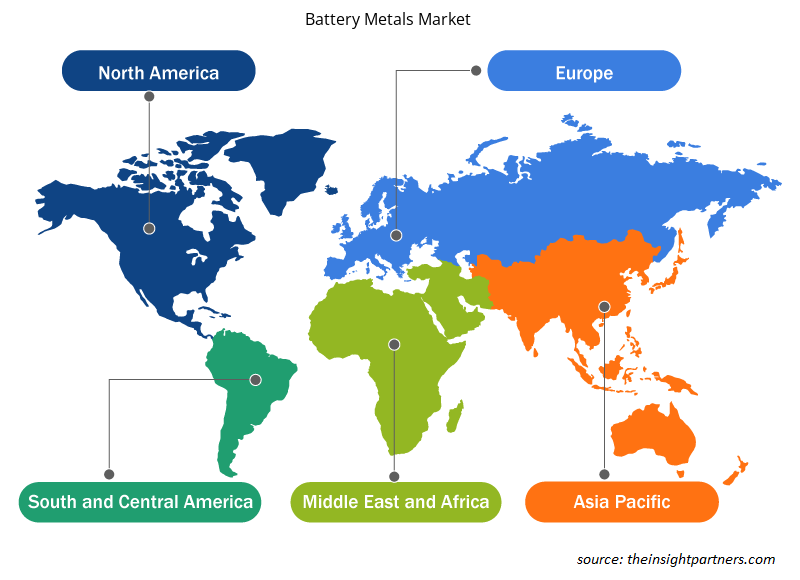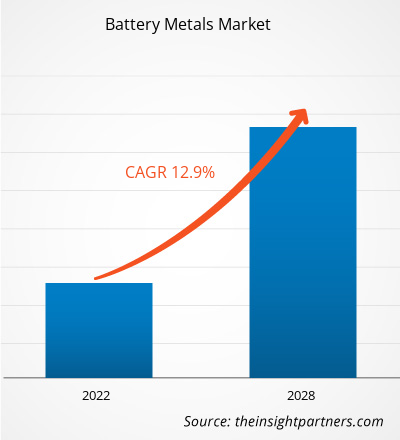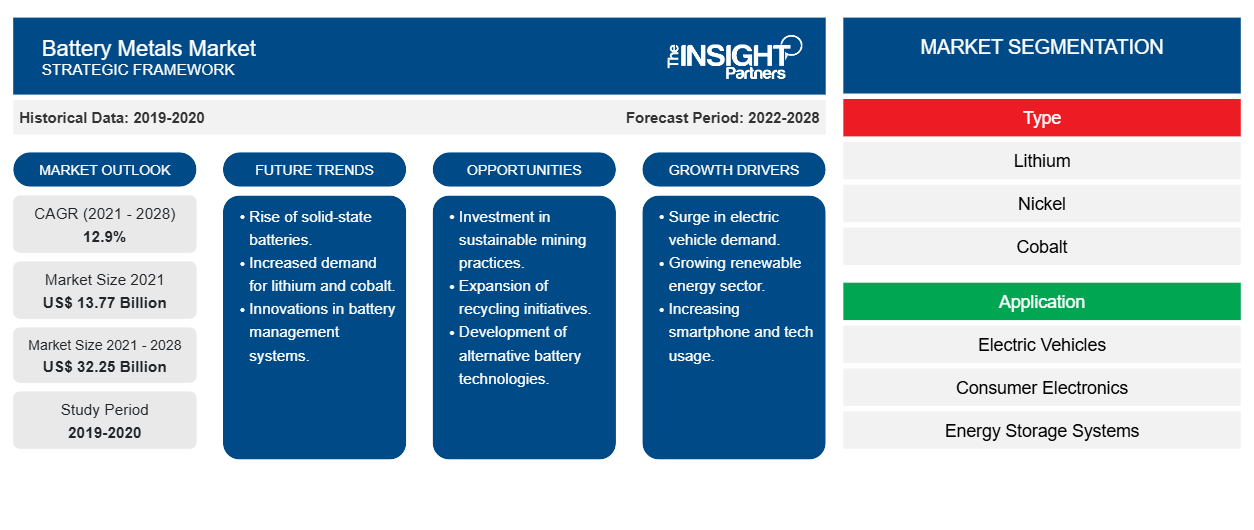[Informe de investigación] Se proyecta que el mercado de metales para baterías alcance los US$ 32.251,1 millones para 2028 desde los US$ 13.770,9 millones en 2021; se espera que crezca a una CAGR del 12,9% entre 2021 y 2028.
Los metales para baterías, como el litio, el cobalto, el níquel y el manganeso, se utilizan como materias primas en la fabricación de baterías. También se emplean en vehículos eléctricos, productos electrónicos de consumo y otras aplicaciones.
En 2020, Asia Pacífico tuvo la mayor participación en los ingresos del mercado mundial de metales para baterías . Varios países de Asia Pacífico están presenciando un auge en las industrias automotriz y electrónica, lo que probablemente seguirá impulsando el crecimiento del mercado de metales para baterías durante el período de pronóstico. Además, el mercado de vehículos eléctricos en APAC ha sido testigo de un crecimiento notable debido al sector automotriz y electrónico en rápida expansión.
Personalice este informe según sus necesidades
Obtendrá personalización en cualquier informe, sin cargo, incluidas partes de este informe o análisis a nivel de país, paquete de datos de Excel, así como también grandes ofertas y descuentos para empresas emergentes y universidades.
-
Obtenga las principales tendencias clave del mercado de este informe.Esta muestra GRATUITA incluirá análisis de datos, desde tendencias del mercado hasta estimaciones y pronósticos.
La pandemia de COVID-19 provocó interrupciones en la cadena de suministro global. Muchas industrias, como la minería y la química y los materiales, se enfrentaron a desafíos sin precedentes para cumplir con los cronogramas de fabricación y entrega y las ventas de diversos bienes. Sin embargo, a medida que las economías planean reactivar sus operaciones, se espera que la demanda de metales para baterías aumente a nivel mundial. La reanudación de las operaciones en las industrias automotriz, electrónica y otras ha aumentado la necesidad de metales para baterías a nivel mundial. La industria de la electrónica de consumo se está expandiendo dinámicamente con el aumento en los gastos de los consumidores. Se espera que el aumento de la demanda de metales para baterías en diversas aplicaciones, como vehículos eléctricos, electrónica de consumo y sistemas de almacenamiento de energía, y las inversiones significativas de los fabricantes destacados impulsen el crecimiento del mercado de metales para baterías en los próximos años.
Perspectivas del mercado
Creciente industria de vehículos eléctricos
El aumento de la demanda de vehículos eléctricos a nivel mundial respalda el crecimiento del mercado de metales para baterías. Los productos a base de metales para baterías son ampliamente utilizados por la industria de vehículos eléctricos como reemplazo de la energía fósil necesaria para el funcionamiento de los vehículos. En áreas densamente pobladas, los vehículos eléctricos se utilizan ampliamente para reducir la contaminación de los vehículos, ya que el número de vehículos utilizados es mayor en dichas áreas. También es un factor importante para proporcionar diversificación energética y reducir la emisión de gases de efecto invernadero. Los beneficios de los vehículos eléctricos incluyen cero emisiones de escape, el potencial de reducción de emisiones de gases de efecto invernadero y una mejor eficiencia que los vehículos con motor de combustión interna.vehicels are widley used to reduce the vehicles pollution as number of vehicles used are more in such areas. It is also important factor for providing energy diversification and reducing greenhouse gas emission. Benefits of electric vehicles include zero tailpipe emissions, the potential for greenhouse gas emissions reductions, and better efficiency than internal combustion engine vehicles.
Los gobiernos de muchos países, entre ellos China, India y Estados Unidos, han aprobado normativas para fomentar la adopción de vehículos eléctricos. Los vehículos eléctricos y su mercado se están expandiendo significativamente debido al continuo progreso tecnológico en la electrificación de vehículos de dos y tres ruedas, autobuses y camiones.three-wheelers, buses, and trucks.
Según el informe de la Agencia Internacional de Energía 'The Global EV Outlook 2020', en 2019 se ha producido una expansión continua del stock mundial de vehículos eléctricos de pasajeros, que alcanzó los 7,2 millones de unidades, un 40 % más que en 2018. Debido a todos estos factores, la demanda de vehículos eléctricos/híbridos y vehículos eléctricos/híbridos enchufables está creciendo, lo que, a su vez, está impulsando sustancialmente el mercado de metales para baterías.EV Outlook 2020' report, there is continuous expansion in global stock of electric passenger vehicles in 2019, reaching 7.2 million units, 40% higher than in 2018. Due to all these factors, the demand for electric vehicles/hybrid and electric vehicles/plug-in hybrid vehicles is growing. This, in turn, is driving the battery metals market substantially.
Perspectivas basadas en tipos
Por tipo, el mercado de metales para baterías se subdivide en litio, níquel, cobalto y otros. El segmento de litio tuvo la mayor participación de mercado en 2020. El crecimiento del segmento se puede atribuir a la creciente aplicación del litio en la industria de los vehículos eléctricos y la electrónica debido a su propiedad de peso ligero.subsegmented into lithium, nickel, cobalt, and others. The lithium segment held the largest market share in 2020. The segment's growth can be attributed to the rising application of lithium in the electric vehicles and electronics industry due to its lightweight property.
Perspectivas basadas en aplicaciones
Según la aplicación, el mercado de metales para baterías se segmenta en vehículos eléctricos, productos electrónicos de consumo, sistemas de almacenamiento de energía y otros. El mercado de metales para baterías está dominado por el segmento de vehículos eléctricos, que registra la CAGR más alta durante el período de pronóstico. La creciente demanda de vehículos libres de contaminación debido al cambio en las normas regulatorias por parte de varias autoridades gubernamentales en los países desarrollados y en desarrollo está creando un gran impacto en el mercado de metales para baterías.
Albemarle Corporation; Umicore; LG Chem; Ganfeng Lithium Co., Ltd.; BASF SE; Bolt Metals Corp.; Honjo Metal Co., Ltd.; Lithium Australia NL; Vale; y Metso Outotec se encuentran entre los actores clave que operan en el mercado de metales para baterías. Estos actores del mercado se centran en el desarrollo de productos innovadores y de alta calidad para satisfacer los requisitos del cliente. Albemarle Corporation anunció el lanzamiento del Centro de Innovación de Materiales para Baterías (BMIC) en su sitio de Kings Mountain, Carolina del Norte. El laboratorio produjo tecnologías de ánodos de metal de litio que aumentaron la densidad energética de la batería mediante el uso de un laminado avanzado de metal de litio para lograr láminas de litio de 20 μm de espesor (es decir, aproximadamente una quinta parte del espesor promedio de un cabello humano) o más delgadas. Jiangsu Ganfeng Power Technology Co., Ltd., una subsidiaria de Ganfeng Lithium Industry, se mudó oficialmente a una nueva planta y mejoró la capacidad de producción mediante el reemplazo de equipos. Jiangsu Ganfeng ofrece sistemas de baterías de litio para vehículos industriales como su producto principal para beneficiar a los clientes con soluciones de sistemas de energía de larga duración, alta resistencia, libres de mantenimiento y personalizables, y facilita la iteración de vehículos industriales de baterías de plomo-ácido a baterías de hierro-litio.
Informe Destacado
- Tendencias progresivas de la industria en el mercado global de metales para baterías que ayudarán a los actores a desarrollar estrategias efectivas a largo plazo
- Estrategias de crecimiento empresarial adoptadas por los mercados desarrollados y en desarrollo
- Análisis cuantitativo del mercado mundial de metales para baterías de 2019 a 2028
- Estimación de la demanda de metales para baterías en diversas industrias
- Avances recientes para comprender el escenario competitivo del mercado y la demanda de vehículos eléctricos
- Tendencias y perspectivas del mercado junto con los factores que impulsan y restringen el crecimiento del mercado de metales para baterías
- Proceso de toma de decisiones mediante la comprensión de las estrategias que sustentan el interés comercial con respecto al crecimiento del mercado global de metales para baterías
- Tamaño del mercado de metales para baterías en varios nodos del mercado
- Descripción detallada y segmentación del mercado global de metales para baterías y su dinámica en la industria
- Tamaño del mercado de metales para baterías en varias regiones con oportunidades de crecimiento prometedoras
Perspectivas regionales del mercado de metales para baterías
Los analistas de Insight Partners explicaron en detalle las tendencias y los factores regionales que influyen en el mercado de metales para baterías durante el período de pronóstico. Esta sección también analiza los segmentos y la geografía del mercado de metales para baterías en América del Norte, Europa, Asia Pacífico, Oriente Medio y África, y América del Sur y Central.

- Obtenga datos regionales específicos para el mercado de metales para baterías
Alcance del informe sobre el mercado de metales para baterías
| Atributo del informe | Detalles |
|---|---|
| Tamaño del mercado en 2021 | US$ 13,77 mil millones |
| Tamaño del mercado en 2028 | US$ 32,25 mil millones |
| CAGR global (2021-2028) | 12,9% |
| Datos históricos | 2019-2020 |
| Período de pronóstico | 2022-2028 |
| Segmentos cubiertos |
Por tipo
|
| Regiones y países cubiertos |
América del norte
|
| Líderes del mercado y perfiles de empresas clave |
|
Densidad de actores del mercado: comprensión de su impacto en la dinámica empresarial
El mercado de metales para baterías está creciendo rápidamente, impulsado por la creciente demanda de los usuarios finales debido a factores como la evolución de las preferencias de los consumidores, los avances tecnológicos y una mayor conciencia de los beneficios del producto. A medida que aumenta la demanda, las empresas amplían sus ofertas, innovan para satisfacer las necesidades de los consumidores y aprovechan las tendencias emergentes, lo que impulsa aún más el crecimiento del mercado.
La densidad de actores del mercado se refiere a la distribución de las empresas o firmas que operan dentro de un mercado o industria en particular. Indica cuántos competidores (actores del mercado) están presentes en un espacio de mercado determinado en relación con su tamaño o valor total de mercado.
Las principales empresas que operan en el mercado de metales para baterías son:
- Corporación Albemarle
- Metales para pernos
- Compañía de litio Ganfeng, Ltd.
- Umicore
- LG Química
Descargo de responsabilidad : Las empresas enumeradas anteriormente no están clasificadas en ningún orden particular.

- Obtenga una descripción general de los principales actores clave del mercado de metales para baterías
Mercado de metales para baterías, por tipo
- Litio
- Níquel
- Cobalto
- Otros
Mercado de metales para baterías, por aplicación
- Vehículos eléctricos
- Electrónica de consumo
- Sistemas de almacenamiento de energía
- Otros
Perfiles de empresas
- Corporación Albemarle
- Umicore
- LG Química
- Compañía de litio Ganfeng, Ltd.
- BASF SE
- Corporación de metales Bolt.
- Compañía Metalúrgica Honjo, Ltd.
- Litio Australia NL
- Valle
- Metso Outotec
- Elementos americanos
- Análisis histórico (2 años), año base, pronóstico (7 años) con CAGR
- Análisis PEST y FODA
- Tamaño del mercado, valor/volumen: global, regional y nacional
- Industria y panorama competitivo
- Conjunto de datos de Excel
Informes recientes
Informes relacionados
Testimonios
Razón para comprar
- Toma de decisiones informada
- Comprensión de la dinámica del mercado
- Análisis competitivo
- Información sobre clientes
- Pronósticos del mercado
- Mitigación de riesgos
- Planificación estratégica
- Justificación de la inversión
- Identificación de mercados emergentes
- Mejora de las estrategias de marketing
- Impulso de la eficiencia operativa
- Alineación con las tendencias regulatorias























 Obtenga una muestra gratuita para - Mercado de metales para baterías
Obtenga una muestra gratuita para - Mercado de metales para baterías